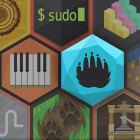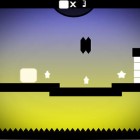By Tanner Higgin, Common Sense Education
The success and popularity of Minecraft in and out of classrooms is no surprise. It's one of the best examples of the potential of learning with games because it embraces exploration, discovery, creation, collaboration, and problem-solving while allowing teachers to shepherd play toward any subject area.
But Minecraft is not the only game of this kind. Take a look at some of these.
1. Garry's Mod
 Garry's Mod (GMod) is a sandbox game like Minecraft but instead of building and exploring, students use a fun physics engine that simulates things like gravity and mass. They also use a virtual toy box of assets from Valve Software's popular games. The tool is a step up in complexity from the elegant simplicity of Minecraft, but with Garry's Mod, students are exposed to physics concepts while having madcap fun.
Garry's Mod (GMod) is a sandbox game like Minecraft but instead of building and exploring, students use a fun physics engine that simulates things like gravity and mass. They also use a virtual toy box of assets from Valve Software's popular games. The tool is a step up in complexity from the elegant simplicity of Minecraft, but with Garry's Mod, students are exposed to physics concepts while having madcap fun.
2. Kerbal Space Program
 Kerbal Space Program has a robust physics engine too, but it's more focused than Garry's Mod. Players purchase rocket parts, put them together, and then see if they can get a ship into orbit, to one of two moons, or even to another planet. These aren't easy tasks, so play is focused on trial and error testing, and, like Minecraft, seeking help from the community is part of a successful strategy.
Kerbal Space Program has a robust physics engine too, but it's more focused than Garry's Mod. Players purchase rocket parts, put them together, and then see if they can get a ship into orbit, to one of two moons, or even to another planet. These aren't easy tasks, so play is focused on trial and error testing, and, like Minecraft, seeking help from the community is part of a successful strategy.
3. Sound Shapes
 Sound Shapes is a visually stunning platform puzzle game set to a rich musical soundscape. Even better: students can create and share their own levels – like interactive sheet music -- using sounds and objects unlocked by playing the platform game. It's an accessible entry point into musical composition as well as game design, and provides an experience that builds on the creativity of Minecraft while offering something wholly unique for music lovers.
Sound Shapes is a visually stunning platform puzzle game set to a rich musical soundscape. Even better: students can create and share their own levels – like interactive sheet music -- using sounds and objects unlocked by playing the platform game. It's an accessible entry point into musical composition as well as game design, and provides an experience that builds on the creativity of Minecraft while offering something wholly unique for music lovers.
4. DIY
 For creative kids who want to get their hands dirty, check out DIY, a site where students can find things to build, instructions for how to build them, and ways to share their creations with others. All projects are aligned to 50 skills that run the gamut from outdoors to indoors, and feature various challenges to complete and cool badges to earn and display.
For creative kids who want to get their hands dirty, check out DIY, a site where students can find things to build, instructions for how to build them, and ways to share their creations with others. All projects are aligned to 50 skills that run the gamut from outdoors to indoors, and feature various challenges to complete and cool badges to earn and display.
5. STENCYL
 Computer programming is a great next step for students who love to mod Minecraft or toy around with the redstone resource (which simulates basic logic and circuitry). One solid entry-level tool is Stencyl, a game creation program focused on codeless, cross-platform game making. By snapping blocks of code together, students can create games that can be published and played on a variety of platforms including mobile phones.
Computer programming is a great next step for students who love to mod Minecraft or toy around with the redstone resource (which simulates basic logic and circuitry). One solid entry-level tool is Stencyl, a game creation program focused on codeless, cross-platform game making. By snapping blocks of code together, students can create games that can be published and played on a variety of platforms including mobile phones.
6. CODECADEMY
 Codecademy is a web-based, self-paced site that teaches actual industry-standard languages like PHP, Javascript, Python, Ruby, HTML, and CSS. While students don't create publishable games like they would in Stencyl, their learning is purpose-driven and contextualized, e.g. JavaScript for web development or Ruby for app development. And students do get to see their code's output directly onscreen.
Codecademy is a web-based, self-paced site that teaches actual industry-standard languages like PHP, Javascript, Python, Ruby, HTML, and CSS. While students don't create publishable games like they would in Stencyl, their learning is purpose-driven and contextualized, e.g. JavaScript for web development or Ruby for app development. And students do get to see their code's output directly onscreen.

